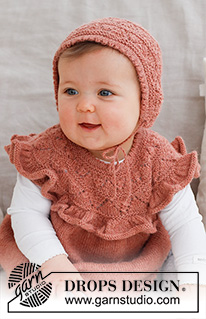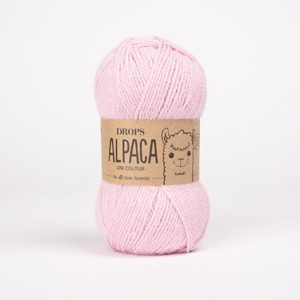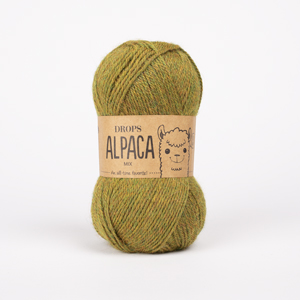Comments / Questions (12)
![]() Pauline Arigno wrote:
Pauline Arigno wrote:
Bonjour, Après l'instruction "couper le fil" comment peut-on tricoter la suite ? Je suis novice en tricot. Merci d'avance
10.10.2024 - 11:51DROPS Design answered:
Bonjour Mme Arigno, avec la même pelote ou bien une autre, continuez à tricoter en commençant sur l'endroit les mailles de la partie centrales (les 21 à 27 mailles), celles qui restent sur l'aiguille autrement dit. Bon tricot!
10.10.2024 - 15:58
![]() Kim Sanderson wrote:
Kim Sanderson wrote:
Hi there, just checking on A.1. I’m knitting second size at 83 stitches. If I work the chart 10x = 80. With I stitch garter at each end, I will have 1 extra stitch. Do I just knit or purl it at end?
21.06.2024 - 23:27DROPS Design answered:
Dear Kim, it says in the pattern: 1 stitch in garter stitch, work A.1, 9-10-11 (12) times, work the first stitch in A.1 so the pattern is symmetrical and 1 stitch in garter stitch. So, you work the first stitch in A.1 in the next to last stitch, then the edge stitch in garter stitch. Happy knitting!
23.06.2024 - 19:03
![]() Adelgunde Baier wrote:
Adelgunde Baier wrote:
Hallo, wenn ich diese Mütze in kraus rechts stricke muss ich die Abnahmen auch auf diese Weise stricken? Mit freundlichen Grüßen Adelgunde Baier
07.04.2024 - 09:06DROPS Design answered:
Liebe Frau Baier, bei diesem Modell wird das hintere Teil von der Mütze (das mit den Abnahmen) krausrechts gestrickt. Viel Spaß beim Stricken!
08.04.2024 - 08:12
![]() Raffaela wrote:
Raffaela wrote:
Ho eeli realizzato la cuffietta come da descrizione. Complimenti per le descrizioni che sono veramente accurate e precise. Unica domanda è questa: i cordini arrotolati girano tutti intorno alla cuffia o solo nel bordo del collo? Cioè anche intorno alla testa? Grazie per una risposta e complimenti ancora ciao
13.03.2024 - 18:07DROPS Design answered:
Buongiorno Raffaella, i cordini sono inseriti nel bordo traforato. Buon lavoro!
16.03.2024 - 18:55
![]() Maria Hilitos wrote:
Maria Hilitos wrote:
Me encanto esta precioso. Muchas gracias por el tutorial.
06.03.2024 - 16:50
![]() Brigitte Flamand wrote:
Brigitte Flamand wrote:
Au moment des diminutions 2 je dois continuer à tricoter les mailles laissées sur les côtés ou pas ? contrairement au diminution 1
17.03.2023 - 21:03DROPS Design answered:
Bonjour Mme Flamand, la diminution-1 est expliquée dans la diminution-2, autrement dit, vous tricotez la m suivante en attente avant la partie centrale avec la 1ère m de la partie centrale, tricotez 2 m ens à l'end, tricotez jusqu'à ce qu'il reste 3 m de la partie centrale, tricotez 2 m ens torse à l'end et tricotez ensemble à l'end la dernière m de la partie centrale et la m suivante en attente. Bon tricot!
20.03.2023 - 09:49
![]() Annick LECLAIR wrote:
Annick LECLAIR wrote:
Bonjour. j'ai des problèmes avec le diagramme, il y a plus de jetés que de maille ensemble diminuées, comment faire pour garder le même nombre de mailles?
06.03.2023 - 11:49DROPS Design answered:
Bonjour Mme Leclair, dans les deux diagrammes A.1 et A.2 vous devez avoir le même nombre de jetés que de mailles à diminuer - dans A.1, vous diminuez 2 m au milieu (= glissez 1 m, tricotez 2 m et passez la m glissée par-dessus la m tricotée) et faites 2 jetés (1 avant et 1 après cette diminution); dans A.2, on diminue 1 m (= 2 m ens à l'end) et on fait 1 jeté ; autrement dit le nombre de mailles va toujours rester le même. Pour A.1, n'hésitez pas à mettre un marqueur après chaque diagramme, vous pourrez ainsi contrôler que vous avez toujours bien 8 mailles. Bon tricot!
06.03.2023 - 14:58
![]() Anna wrote:
Anna wrote:
Ik begrijp niet hoe de kantrand gemaakt moet worden. Ik heb 71 steken op mijn naald (ik maak de kleinste maat). Wordt A2 herhaald tot alle steken op de naald gebreid zijn? Maar dan kom ik toch niet uit met oneven steken? Met vriendelijke groet, Anna
02.02.2023 - 19:48
![]() Anne wrote:
Anne wrote:
”Se tricote en aller et retour sur aiguilles circulaires” Donc, on ne tricote pas en rond en fermant le tricot. Du coup, peut le tricoter aux aiguilles droites? Merci beaucoup de votre réponse.
19.12.2022 - 19:21DROPS Design answered:
Bonjour Anne, tout à fait, vous pouvez utiliser des aiguilles droites si vous êtes plus à l'aise - retrouvez ici d'autres infos sur les aiguilles circulaires. Bon tricot!
20.12.2022 - 08:59
![]() PEMANA wrote:
PEMANA wrote:
El gráfico A1 hay que empezarlo por abajo no? Para que el dibujo quede como en la foto .
08.10.2022 - 13:03DROPS Design answered:
Hola PEMANA, los diagramas se leen siempre de abajo arriba y de derecha a izquierda (en las filas por el lado derecho) o de izquierda a derecha (en las filas por el lado revés).
09.10.2022 - 18:55
Sweet Primrose Bonnet#sweetprimrosebonnet |
||||||||||||||||
 |
 |
|||||||||||||||
Knitted hat / bonnet for baby in DROPS Alpaca. The piece is worked with lace pattern. Sizes 0 – 2 years.
DROPS Baby 43-16 |
||||||||||||||||
|
------------------------------------------------------- EXPLANATIONS FOR THE PATTERN: ------------------------------------------------------- RIDGE/GARTER STITCH (worked back and forth): Knit all rows. 1 ridge = knit 2 rows. PATTERN: See diagrams A.1 and A.2. The diagrams show all rows in the pattern from the right side. DECREASE TIP-1: All decreases are worked from the right side! BEFORE THE MID-SECTION: Knit together the last stitch from the thread/extra needle and the first stitch from the mid-section. AFTER THE MID-SECTION: Knit twisted together the last stitch from the mid-section and the first stitch from the thread/extra needle. DECREASE TIP-2: All decreases are worked from the right side! AT THE BEGINNING OF THE MID-SECTION: Work the outermost stitch of mid-section together with the next stitch from thread/extra needle as before, knit the next 2 stitches together. AT THE END OF THE MID-SECTION: Work until there are 3 stitches left on the mid-section, knit 2 twisted together, knit the last stitch together with the next stitch from thread/extra needle as before. ------------------------------------------------------- START THE PIECE HERE: ------------------------------------------------------- HAT – SHORT OVERVIEW OF THE PIECE: The piece is worked back and forth with circular needle from mid-front. Side stitches are placed on a thread and the mid-section is worked separately, then knitted together with the stitches on the threads. A lace edge is worked around the hat and a twisted cord threaded through the holes to finish. HAT: Cast on 75-83-91 (99) stitches with circular needle size 3 mm and DROPS Alpaca. Change to circular needle size 2.5 mm and work 4 rows of stocking stitch with 1 stitch in GARTER STITCH on each side – read description above. Work the next row from the right side as follows: 1 stitch in garter stitch, * knit 2 together, 1 yarn over *, work from *-* until there are 2 stitches left, knit 1 and 1 stitch in garter stitch (folding edge). Work 5 rows of stocking stitch with 1 stitch in garter stitch on each side. Change to circular needle size 3 mm. Work the next row from the right side as follows: 1 stitch in garter stitch, work A.1, 9-10-11 (12) times, work the first stitch in A.1 so the pattern is symmetrical and 1 stitch in garter stitch. Continue this pattern back and forth. REMEMBER THE KNITTING TENSION! Work until the piece measures approx. 11-12-13 (14) cm from the folding edge – finish after row 4 or 12 in A.1. Place the outermost 27-30-33-36 stitches on each side on separate threads/extra needles. There are 21-23-25-27 stitches on the needle (mid-section). Cut the strand. Start from the right side and work garter stitch back and forth over the mid-section – AT THE SAME TIME on each row from the right side work together the outermost stitch on each thread/extra needle with its nearest stitch from the mid-section – read DECREASE TIP-1. AT THE SAME TIME when the mid-section measures 4-4-5 (5) cm decrease 1 stitch on each side of the mid-section – read DECREASE TIP-2. Repeat this decrease when the mid-section measures 7-7-8 (9) cm and 10-10-11 (13) cm = 15-17-19 (21) stitches on the mid-section. Continue working until all the stitches from the threads/extra needles have been worked together with the mid-section. Keep the stitches on the needle. ASSEMBLY: Fold the edge of the hat to the wrong side and sew down, giving a double edge. To avoid the edge being tight and rolling outwards it is important that the seam is elastic. LACE EDGE: Start from the right side at the bottom, using circular needle size 2.5 mm and knit up 28-31-34 (35) stitches inside the 1 edge stitch from the folded edge and up to the mid-section, knit the 15-17-19 (21) stitches from the mid-section and knit up 28-31-34 (35) stitches inside the 1 edge stitch from the mid-section to the folded edge = 71-79-87 (91) stitches (the number of stitches should be divisible by 4 + 3). Start from the wrong side and work A.2 (on row 5 in A.2 work the symbols from the wrong side, i.e. knit 2 together, 1 yarn over). When A.2 is finished change to circular needle size 3 mm. Cast off. TWISTED CORD: Cut 2 strands DROPS Alpaca of 3 metres. Twist them together until they begin to resist, fold the cord double and it will continue to twist. Tie a knot in each end. Thread the cord through the row of holes along the edge. |
||||||||||||||||
Diagram explanations |
||||||||||||||||
|
||||||||||||||||

|
||||||||||||||||
Have you finished this pattern?Tag your pictures with #dropspattern #sweetprimrosebonnet or submit them to the #dropsfan gallery. Do you need help with this pattern?You'll find 21 tutorial videos, a Comments/Questions area and more by visiting the pattern on garnstudio.com. © 1982-2025 DROPS Design A/S. We reserve all rights. This document, including all its sub-sections, has copyrights. Read more about what you can do with our patterns at the bottom of each pattern on our site. |
||||||||||||||||































































Post a comment to pattern DROPS Baby 43-16
We would love to hear what you have to say about this pattern!
If you want to leave a question, please make sure you select the correct category in the form below, to speed up the answering process. Required fields are marked *.